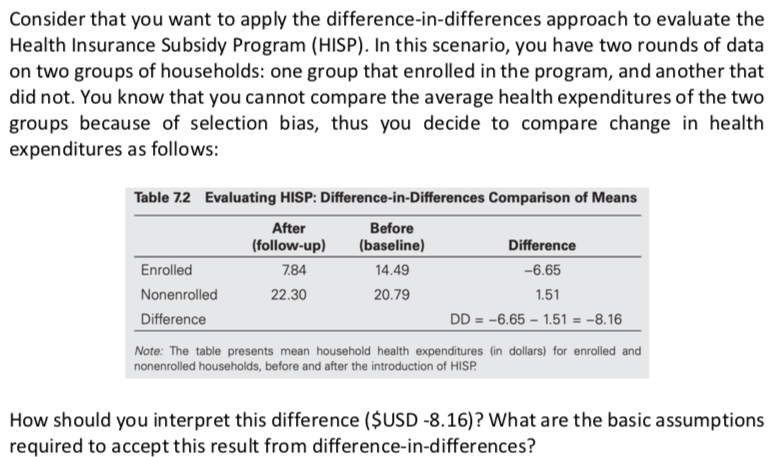Consider that you want to apply the difference-in-differences approach to evaluate the Health Insurance Subsidy Program (HISP). In this scenario, you have two rounds of data on two groups of households: one group that enrolled in the program, and another that did not. You know that you cannot compare the average health expenditures of the two groups because of selection bias, thus you decide to compare change in health expenditures as follows: Table 7.2 Evaluating HISP: Difference-in-Differences Comparison of Means After Before (follow-up) (baseline) Difference Enrolled 7.84 14.49 -6.65 Nonenrolled 22.30 20.79 1.51
Consider that you want to apply the difference-in-differences approach to evaluate the Health Insurance Subsidy Program (HISP). In this scenario, you have two rounds of data on two groups of households: one group that enrolled in the program, and another that did not. You know that you cannot compare the average health expenditures of the two groups because of selection bias, thus you decide to compare change in health expenditures as follows: Table 7.2 Evaluating HISP: Difference-in-Differences Comparison of Means After Before (follow-up) (baseline) Difference Enrolled 7.84 14.49 -6.65 Nonenrolled 22.30 20.79 1.51
Chapter6: Population Health
Section: Chapter Questions
Problem 9QAP
Related questions
Question

Transcribed Image Text:Consider that you want to apply the difference-in-differences approach to evaluate the
Health Insurance Subsidy Program (HISP). In this scenario, you have two rounds of data
on two groups of households: one group that enrolled in the program, and another that
did not. You know that you cannot compare the average health expenditures of the two
groups because of selection bias, thus you decide to compare change in health
expenditures as follows:
Table 7.2 Evaluating HISP: Difference-in-Differences Comparison of Means
After
Before
(baseline)
(follow-up)
Difference
Enrolled
7.84
14.49
-6.65
Nonenrolled
22.30
20.79
1.51
Difference
DD = -6.65 – 1.51 = -8.16
Note: The table presents mean household health expenditures (in dollars) for enrolled and
nonenrolled households, before and after the introduction of HISP.
How should you interpret this difference ($USD -8.16)? What are the basic assumptions
required to accept this result from difference-in-differences?
Expert Solution
This question has been solved!
Explore an expertly crafted, step-by-step solution for a thorough understanding of key concepts.
Step by step
Solved in 3 steps

Knowledge Booster
Learn more about
Need a deep-dive on the concept behind this application? Look no further. Learn more about this topic, economics and related others by exploring similar questions and additional content below.Recommended textbooks for you

